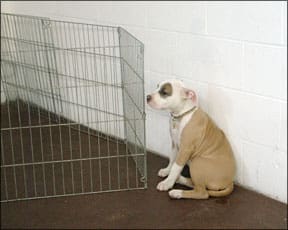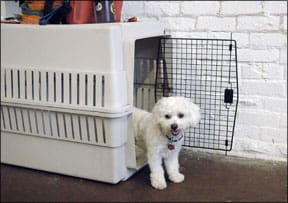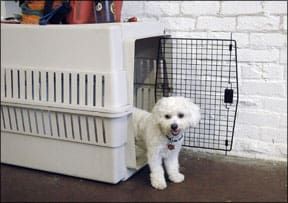Somewhere at this very moment, perhaps at a shelter near you, a frightened dog huddles in the back of her kennel, trembling, terrified by a chaotic overload of sensory stimuli: sights, smells, and sounds that are far beyond her ability to cope. Somewhere, today, a warmhearted, caring person is going to feel sorry for this dog – or one similar – believing that love will be enough to rehabilitate the frightened canine. Sometimes, it is. More often, though, the compassionate adopter finds herself with a much larger project than she bargained for.
While shelters can a prime source for frightened and shy dogs, they are certainly not the only source. Pet stores, puppy mills, rescue groups, and irresponsible breeders (even some who breed top quality show dogs) can all be guilty of foisting off temperamentally unsound (due to genetics/nature) or under-socialized (due to environment/nurture) puppies and adult dogs on unprepared adopters.

This is not to say that no one should adopt a dog with fear-related behaviors. Rather, the point is that if an organization or individual is going to re-home dogs who are timid, shy, or fearful, they have a responsibility to ensure that the adopter knows full well how large a project she may be facing. And if you are thinking of adopting a fearful canine – or already have – you need to have access to good information to help you make a wise and informed decision, and to provide the best quality of life possible for your frightened Fido.
Sensitive soul or shy guy?
In the past, I volunteered to assess dogs for adoption at our local shelter, where my husband was executive director, one day a week, . When we got the list of dogs for the day, the first thing I did was walk through the kennels and take a quick glance at the ones we’d be working with, to get a first impression. I made a mental note of those who appeared shy, frightened, or aggressive.
Some of these we wouldn’t even take out of their kennels, if we felt a dog’s level of aggression or fearfulness was such that it was too great a risk to the safety of the assessor. However, I always liked to give the frightened ones an extra chance. I would go in and sit on the kennel floor, and coax them to trust me enough to say hi. If I could safely leash them, we took them out.
A surprising percentage of these frightened dogs made a miraculous turnaround as soon as we got them outside. These were simply very sensitive dogs who were traumatized by the cacophony that can exist in any kennel environment, be it shelter, vet hospital, or boarding kennel. I like sensitive dogs; they tend to develop close relationships with their humans, make excellent companions, and do exceptionally well in training. They just don’t do well in chaos. Assuming they pass the rest of the assessment process, these sensitive souls are good candidates for adoption.
If they have to sit in the shelter adoption kennels waiting for a home, however, they won’t show well – and will probably wait in that difficult environment for an excruciatingly long time. Under the constant stress of the shelter, their health and behavior are likely to deteriorate until they are no longer suitable adoption candidates. If they can be adopted quickly, or go to a foster home or rescue group where they don’t have to be kenneled in chaos, their prospects for finding a lifelong loving home and leading a normal life are bright.
Far more challenging are the dogs who are truly shy due to lack of adequate socialization, poor breeding, or both. Simply taking them outside or to the relative calm of the assessment room does little to assuage their fear. Unless a shelter or rescue group has considerable resources to devote to behavior modification, or turns a blind eye and allows them to be adopted by an unsuspecting soft-hearted public, these frightened dogs are often euthanized. As long as there are far more dogs than there are homes, triage tragically dictates that the most promising adoption prospects get dibs on the available kennel space and foster homes.
Fixing the fear
Not all fearful dogs are euthanized. Judging from my own clientele and discussions with my peers, plenty of shy guys and gals find their way to loving homes, with owners who want to give them happier lives.
Caution and common sense aside, it’s human nature to want to rescue the doggie in distress – the pup who shrinks away from human contact and looks at the world with fear in his eyes. If you are the rescuer type, you have my respect and admiration. Whether you came by your timid dog through a shelter, rescue, breeder, Craig’s list, or rescued a frightened homeless dog off the street yourself – or are still contemplating such an adoption – rest assured that in all but the most extreme cases, you can help your dog have a reasonably normal life. Some will turn around quickly, some require a long-term commitment to management and modification, and a sad, small percentage may never be rehabilitated.
If you have a timid dog who is not very comfortable with you, and won’t take treats easily enough for you to be able to do counter-conditioning and engage him in training, you’re really starting at square one. You’ll need lots of patience and very realistic expectations as you work to repair the damage caused by lack of socialization or by outright abuse. (By the way, abuse is a less-common cause of severe fearful behavior than you might think; lack of early socialization is much more common.)
You may need to spend a lot of time just sitting quietly in your dog’s presence, reading a book, being as nonthreatening as possible. Keep him in a quiet room in your house. This will be a safe haven for him, so he doesn’t have to deal with all the scary activity in the rest of your home.
Spend as much time as you can sitting on the floor in his room, avoiding eye contact, while keeping your body language relaxed and loose. Scatter bits of high-value treats (chicken, roast beef) on the floor around you, far enough away that your dog might be comfortable eating them while keeping a wary eye on you.
Gradually shrink the circle of treats so he comes nearer to you to get them. Sprinkle some on your pant legs when you think he’s ready to come that close. Finally, rest your hand on your knee, palm up, with treats in them. Be sure not to move your hand as he’s reaching for them, you’ll scare him off!
Sometimes while you’re doing the treats-on-the-floor routine, talk to your dog in a calm, low voice, so he becomes accustomed to hearing your voice, and associates it with tasty stuff. Gradually add more normal human behavior to the interactions. Briefly make eye contact. Move your hand a tiny bit as he’s nibbling treats from it. Increase slight body movements in his vicinity. Try sitting in a chair for the scattered treat routine.

Work up to normal human behavior, always trying to avoid causing a big fear reaction in him as you increase the intensity of your presence as fear-causing stimulus. If you can, keep your interactions “sub-threshold” – below the intensity at which your dog reacts negatively. When he will take food from you, start hand-feeding all his meals.
When he’s reasonably comfortable in your presence, try the umbilical cord method of relationship-building. Attach a leash to his collar and keep him with you as much as possible when you are home, as you move around the house. Until he is braver, return him to his sanctuary if you have guests over, or during periods of high family activity, but bring him out as soon as things settle down.
Try to anticipate when something will be too much for him, so you can prevent a negative reaction, instead of waiting for the reaction to tell you that it’s been too much – but at the same time keep looking for ways to expand his horizons and help him become as normal – and brave – as he’s capable of being.
In the end, it’s all about quality of life – your dog’s and yours. Perhaps you can help your shy dog become completely comfortable in the real world and lead a normal life. Perhaps you’ll always be making some accommodations to help him be happy by keeping him safe at home most or all of the time. As long as you can find a way to bring light to his life, so he’s not in a continual state of fear and anxiety and you’re not constantly stressed by his stress, you will have done a very, very good thing.
If you haven’t adopted yet
Here are some tips for those of you who are thinking about that shy youngster you saw at the shelter the other day, or who suspect your heart will someday be captured by the challenge of an unsocialized pup.
•Get your pup as young as you can. The benefits of staying with his litter until eight weeks of age are outweighed by the benefits of getting started as early as possible with socialization.
•Or, give him the best of both worlds: Take the entire litter, or at least several of the pups, and start them all on the road to a happier life. Then be sure to find capable, knowledgeable adopters who will continue with remedial socialization for his siblings.
•Avoid the temptation to keep more than one pup. They are likely to bond to each other more closely than to you, which makes your socialization challenge many times more difficult. Even well-socialized littermates or same-age pals can have separation problems if raised together.
•Know that love is not enough. Many well-meaning rescuers think that giving a psychologically neglected pup a home filled with love will be enough to “fix” the problem. Don’t fool yourself. Love is an important part of the equation, but it will take a lot of work as well.
Training tips to socialize shy dog
Here are some tips for those who have already adopted a shy guy.
•Locate a qualified positive behavior professional who can work with you to help your dog become more comfortable in his world. Try Pet Professional Guild or the International Association of Animal Behavior Consultants for good lists of positive behavior professionals.
•Have a solid understanding of counter-conditioning and desensitization (CC&D), and make a strong commitment to practice this with your dog every single day.
•Read about the Constructional Aggression Treatment (CAT) procedure and consult with your behavior professional to determine if this procedure might be a useful behavior modification tool in your dog’s program. (See “Building Better Behavior,” Whole Dog Journal May 2008.)
•Teach your dog to target (to touch his nose to a designated target on cue). Dogs get confident about targeting (most love it!), and you can use the behavior to help him be more confident in situations where he’s mildly to moderately fearful. (See “Target: Teach Your Dog to Touch.”)
•Read any or all of these books:
The Cautious Canine
by Patricia McConnell
Dogs are From Neptune
by Jean Donaldson
Help For Your Fearful Dog
by Nicole Wilde
How to Right a Dog Gone Wrong
by Pam Dennison
Scaredy Dog
by Ali Brown
Assertively protect your dog from unwanted advances by well-meaning strangers who want to pet your dog. You must not let people pet or harass him until he is socialized enough to tolerate petting and harassment.
Be prepared for heartache. Some poorly socialized dogs respond well to remedial socialization and grow into reasonably well socialized adult dogs. Others don’t.
If you don’t succeed in enhancing your dog’s social skills, are you prepared to live with a fearful dog who may be at high risk for biting – you, visitors, children, or others? To implement a strict management program to protect him from unwelcome human attention and protect humans from his defensive aggression? Perhaps even make the difficult decision to euthanize, if you decide at some point that his life is too stress-filled to be humane?

Management for shy guys
Remember, training is important, but it’s not the only way to solve dog behavior problems. Consider some of the following dog-management plans:
Manage your dog’s environment to minimize his exposure to stressors until he’s ready and able to handle them.
Consult your veterinarian about medication. Many fearful dogs can benefit greatly from prescription anti-anxiety medication. It is, however, a complex field. If your veterinarian is not behaviorally knowledgeable, ask him or her to do a phone consult with a veterinary behaviorist for help in selecting the right medication(s) and correct dosages. Your vet can find a list of veterinary behaviorists here.
Explore nutraceuticals. A nutraceutical is a product isolated or purified from foods that is generally sold in medicinal forms not usually associated with food. A nutraceutical is demonstrated to have a physiological benefit or provide protection against chronic disease.” Two that are FDA approved for use in dogs are Anxitane (L-theanine) and Zylkene (casein). You might read about these and if they interest you, discuss them with your veterinarian to be sure s/he is comfortable with you using them for your dog. If so, you can get them through your vet, or at Amazon.com. I have had good success with over-the-counter L-theanine (from a vitamin/nutrition store) – usually more affordable than Anxitane. I use the capsules – open and sprinkle on your dog’s food. If you get the chewable tablets, do not get any that contain Xylitol, which is deadly toxic to dogs.
Try Adaptil (containing “dog appeasing pheromones”) to see if it helps ease his anxiety. If it seems to, keep an Adaptil dispenser plugged into a wall socket in your dog’s sanctuary room – out of his reach if he’s a chewer – and use the spray on a bandana around his neck when you take him out of his safe zone.
Feed your dog a diet that includes high-quality protein. Low-quality protein may interfere with his ability to utilize serotonin, a substance produced naturally by his body that helps keep him calm. Among other things, serotonin plays an important role as a neurotransmitter in the modulation of anger, aggression, mood, and sleep.
Consider trying an Anxiety Wrap, a snug-fitting garment designed to give your dog that calming “swaddled” feeling. Or try the economic alternative, fitting him with a snug T-shirt. See “It’s a Wrap!” (December 2002) and anxietywrap.com for more information.
Try a Thunder Cap when you must expose your dog to super-threshold visual stimuli. Similar to the hood that falconers use to keep their birds from being overstimulated, the cap is made of a sheer nylon that allows dogs to see shapes but not detail, thus reducing the intensity of visual stimuli. The Thunder Cap is available at: https://thundershirt.com/products/thundercap-for-dogs
Use your hands to help your dog relax through the use of TTouch or other calming massage. For more information on TTouch, visit ttouch.com.
Consider the use of aromatherapy in conjunction with TTouch or massage. If you use a lavender aromatherapy product while you massage your dog, you can then use the scent of lavender in other potentially stressful situations to help your dog maintain his cool. His association between the scent and being calm can transfer to other places.
See “Smell This, You’ll Feel Better,” December 2004; “Essential Information,” January 2005; and “Canines in a Mist,” April 2005, for more information about using aromatherapeutic products.
Consult your holistic veterinarian about the use of other agents such as calming herbs to help your dog deal with difficult situations.
Editor’s Note: This story was updated on December 17, 2020.






